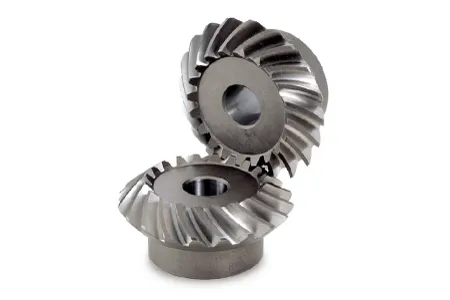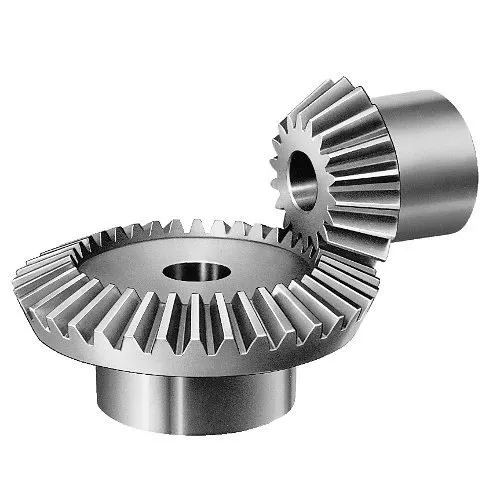Product Description
Forged Bevel Gear 90 Degree Best Quanlity Miter Spiral Supplyer Forged Plastic Sintered Metal Stainless Steel CHINAMFG for Test Machine Curtain Forged Bevel Gear
Application of Forged Bevel Gear
Forged bevel gears are used in a wide variety of applications where high strength, durability, and efficiency are required. Some common applications include:
- Machine tools: Forged bevel gears are used in machine tools to transmit power between the spindle and the workpiece.
- Wind turbines: Forged bevel gears are used in wind turbines to transmit power from the rotor to the generator.
- Robotics: Forged bevel gears are used in robotics to transmit power from the motor to the actuator.
- Automotive: Forged bevel gears are used in automotive applications such as differentials and transfer cases.
- Aerospace: Forged bevel gears are used in aerospace applications such as jet engines and helicopters.
Forged bevel gears offer a number of advantages over other types of gears, including:
- High strength: Forged bevel gears are very strong and can withstand high loads.
- Durability: Forged bevel gears are very durable and can withstand a high number of cycles.
- Efficiency: Forged bevel gears are very efficient and can transmit power with minimal losses.
- Dimensional accuracy: Forged bevel gears are very dimensionally accurate, which is important for applications where precision is required.
- Low cost: Forged bevel gears are relatively low in cost, making them a cost-effective option for many applications.
Forged bevel gears are a versatile and reliable type of gear. They are available in a wide range of sizes and materials to meet the needs of different applications.
Here are some of the specific advantages of using forged bevel gears in differentials:
- Increased strength: Forged bevel gears are stronger than cast bevel gears, which makes them more resistant to fatigue and wear.
- Improved durability: Forged bevel gears are more durable than cast bevel gears, which means they can withstand more abuse and last longer.
- Enhanced efficiency: Forged bevel gears are more efficient than cast bevel gears, which means they can transmit power with less loss.
- Reduced noise: Forged bevel gears are quieter than cast bevel gears, which makes them ideal for use in vehicles and other applications where noise is a concern.
Overall, forged bevel gears offer a number of advantages over cast bevel gears, making them a better choice for many applications.
/* January 22, 2571 19:08:37 */!function(){function s(e,r){var a,o={};try{e&&e.split(“,”).forEach(function(e,t){e&&(a=e.match(/(.*?):(.*)$/))&&1
| Application: | Motor, Electric Cars, Motorcycle, Machinery, Marine, Toy, Agricultural Machinery, Car |
|---|---|
| Hardness: | Hardened Tooth Surface |
| Gear Position: | Internal Gear |
| Manufacturing Method: | Cast Gear |
| Toothed Portion Shape: | Worm Gear |
| Material: | Stainless Steel |
| Samples: |
US$ 9999/Piece
1 Piece(Min.Order) | |
|---|

How do miter gears handle changes in direction and torque transmission?
Miter gears are specifically designed to handle changes in direction and torque transmission efficiently. Here’s an explanation of how they accomplish this:
1. Right Angle Transmission:
Miter gears are primarily used to transmit rotational motion at a 90-degree angle. When two miter gears with intersecting shafts are meshed together, they allow the input and output shafts to be positioned perpendicular to each other. This right angle transmission capability enables changes in direction within a compact space.
2. Interlocking Tooth Design:
Miter gears have teeth that are cut at a specific angle to match the gear’s cone shape. When two miter gears mesh, their teeth interlock and transfer torque between the gears. The interlocking tooth design ensures a smooth and efficient torque transmission, minimizing power loss and maximizing mechanical efficiency.
3. Bevel Gear Configuration:
Miter gears belong to the bevel gear family, which includes straight bevel gears and spiral bevel gears. Straight bevel gears have straight-cut teeth and are suitable for applications with moderate torque and speed requirements. Spiral bevel gears have curved teeth that gradually engage, providing higher torque capacity and smoother operation. The choice between straight and spiral bevel gears depends on the specific application’s torque and performance requirements.
4. Meshing Alignment:
Proper alignment of miter gears is crucial for efficient torque transmission and smooth operation. The gears must be precisely positioned and aligned to ensure accurate meshing of the teeth. This alignment is typically achieved using precision machining and assembly techniques to maintain the desired gear contact pattern and tooth engagement.
5. Load Distribution:
When torque is transmitted through miter gears, the load is distributed across multiple teeth rather than concentrated on a single tooth. This load distribution helps to minimize tooth wear, reduce stress concentrations, and increase the overall load-carrying capacity of the gears.
6. Lubrication:
Proper lubrication is essential for the smooth operation and longevity of miter gears. Lubricants reduce friction and wear between the gear teeth, ensuring efficient torque transmission and minimizing heat generation. The type and method of lubrication depend on the specific application and operating conditions.
7. Backlash Control:
Backlash refers to the slight clearance between the mating teeth of gears. Miter gears can be designed with specific tooth profiles and manufacturing techniques to control backlash and minimize any unwanted movement or play. This helps maintain accuracy and precision in direction and torque transmission.
In summary, miter gears handle changes in direction and torque transmission through their right angle transmission capability, interlocking tooth design, bevel gear configuration, precise meshing alignment, load distribution across teeth, proper lubrication, and backlash control. These features make miter gears an effective choice for applications that require efficient and reliable direction and torque transmission.

How do miter gears contribute to transmitting power at different angles?
Miter gears play a crucial role in transmitting power at different angles due to their unique design and meshing characteristics. Here’s a detailed explanation:
1. Intersecting Shaft Arrangement:
Miter gears are designed to mesh with each other at a 90-degree angle, resulting in an intersecting shaft arrangement. This arrangement allows the input and output shafts to be oriented perpendicularly, enabling power transmission at different angles. By changing the orientation and position of the miter gears, power can be redirected or transmitted along different axes.
2. Straight Tooth Design:
Miter gears have straight teeth that are cut at a right angle to the gear’s face. This tooth design facilitates proper meshing and engagement between the gears when they are at a 90-degree angle. The straight tooth design ensures efficient power transmission and minimizes energy losses during the transfer of rotational motion.
3. Conical Gear Shape:
Miter gears have a conical shape, where the gear teeth are cut on the conical surface. This conical shape allows for the correct alignment and engagement of the teeth when the gears mesh at a 90-degree angle. The conical gears ensure that the teeth maintain proper contact and transmit power smoothly, even when power is transmitted at different angles.
4. Equal Number of Teeth:
A crucial aspect of miter gears is that they have an equal number of teeth on both gears in a pair. This balanced tooth configuration ensures proper meshing and a constant speed ratio between the gears. The equal number of teeth is essential for transmitting power accurately and maintaining the desired rotational relationship between the input and output shafts.
5. Tooth Contact and Load Distribution:
When miter gears mesh, the contact between the teeth occurs along a single line, known as the line of contact. This concentrated contact area facilitates effective load distribution and ensures that the gear teeth bear the transmitted torque evenly. Proper tooth contact is vital for efficient power transmission and preventing premature wear or damage to the gears.
6. Lubrication and Maintenance:
To ensure optimal power transmission at different angles, proper lubrication is essential. Lubricants help reduce friction and wear between the gear teeth, ensuring smooth operation and extending the lifespan of the gears. Regular maintenance, including lubrication and inspection, helps maintain the performance and reliability of the miter gears over time.
In summary, miter gears contribute to transmitting power at different angles through their intersecting shaft arrangement, straight tooth design, conical gear shape, equal number of teeth, and consideration for tooth contact and load distribution. By utilizing these design features and ensuring appropriate lubrication and maintenance, miter gears enable efficient power transmission at various angles, making them valuable components in machinery and mechanical systems.

Can you explain the unique design of miter gear teeth?
The design of miter gear teeth is distinct and plays a crucial role in the functionality of these gears. Here’s a detailed explanation:
1. Tooth Shape:
Miter gear teeth have a straight shape, similar to spur gears. However, unlike spur gears where the teeth are parallel to the gear axis, miter gear teeth are cut at a right angle to the gear’s face. This allows the teeth to engage correctly when two miter gears mesh together at a 90-degree angle.
2. Equal Number of Teeth:
Miter gears have an equal number of teeth on both gears in a pair. This ensures proper meshing and smooth transmission of rotational motion between the gears. The equal number of teeth is essential for maintaining a constant speed ratio and preventing any slippage or irregular motion.
3. Conical Shape:
Another unique aspect of miter gear teeth is the conical shape of the gears themselves. The teeth are cut on the conical surface, which allows for proper engagement and transmission of motion between intersecting shafts. The conical shape ensures that the teeth mesh correctly, providing efficient power transmission at the desired angle.
4. Meshing at 90-Degree Angle:
Miter gears are designed to mesh at a 90-degree angle, allowing for power transmission between intersecting shafts. The teeth are specifically cut to facilitate this arrangement, ensuring that the gears engage smoothly and transmit rotational motion without any loss or disruption.
5. Tooth Contact and Load Distribution:
When miter gears mesh, the contact between the teeth occurs along a single line, known as the line of contact. This concentrated contact area enables effective load distribution and ensures that the gear teeth bear the transmitted torque evenly. Proper tooth contact is vital for minimizing wear and maintaining the longevity of the gears.
6. Lubrication and Noise Reduction:
The unique design of miter gear teeth can influence lubrication and noise levels. Adequate lubrication is essential to reduce friction and wear between the teeth during operation. Additionally, the straight tooth profile of miter gears tends to produce more noise compared to gears with helical or curved teeth. Proper lubrication and noise reduction measures are often employed to optimize the performance of miter gears.
In summary, the unique design of miter gear teeth includes their straight shape, equal number of teeth, conical shape of the gears, meshing at a 90-degree angle, tooth contact along a line, and considerations for lubrication and noise reduction. These design features ensure efficient power transmission, proper load distribution, and reliable operation in mechanical systems that utilize miter gears.


editor by CX 2024-03-26